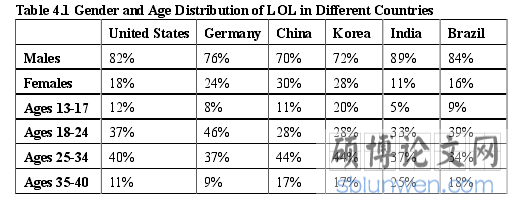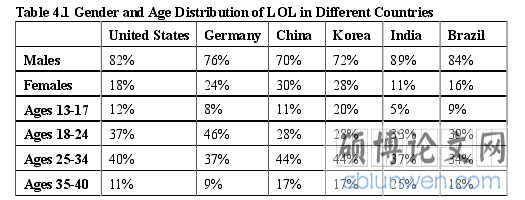Chapter One Introduction
1.1 Research Background and Significance
In 2000, James Hollan, Edwin Hutchins together with David Kirsh put forward that we passed “through the historical moment when people work in front of a single computer” (Hollan, Hutchins, David Kirsh, 2000: 174). It is undoubtable that computer is one the greatest inventions in human history and people around the world have further promoted cultural exchanges with the help of it. What is worth noting is that in the process of the rapid popularization of computer as well as the Internet, the emergence of video games has also opened a new window for the integration and collision of different cultures. Video games were introduced in the 1970s as a commercial entertainment medium and then served as the basis of the important entertainment industry in Japan, the United States, and Europe in the late 1970s. And “China has been the largest, highest grossing and the most profitable video game market in the world in recent years and has been described as the ‘Games Industry Capital of the World’ as its market size has exceeded that of the US in 2017” (Xin Yue, 2019: 1). According to the 2018 China Gaming Industry Report, the actual sales revenue of the Chinese game market in 2018 reached 214.44 billion yuan and the year-on-year growth is 5.3%, accounting for 23.6% of the global share.
In order to actively exploit the global gaming market, many companies abroad such as Riot Games, Valve Software and Blizzard Entertainment have sought cooperation with video game companies in China and exported their featured games into Chinese market. And in the process of localization, it is certain that translation of texts in games plays a crucial role and League of Legends (LOL) has been successfully localized in China with the subtle translation as well as some special Chinese elements involved.
......................
1.2 Methodology and Research Questions
This study aims to analyze the strategies used in the translation of champion names in LOL based on the Skopos theory. The text to be studied is from the official websites of LOL. And the author collects the names and titles from both English and Chinese websites and put them in a list correspondingly. By collecting and analyzing the translation of these names and titles, this study attempts to answer these questions:
1. What are the language features of name and title translation in LOL?
2. What are the influential factors that affect name and title translation of LOL and how they influence the translation?
3. What translation strategies are mainly used in the translation of champion names and titles in LOL? Together with quantitative analysis, this article uses qualitative analysis as the main method. The analysis of the translation strategies used in this video game that is the main body of this study is discussed through qualitative analysis. Quantitative analysis is used several times in the analysis of target audience, influential factors of the translation strategies and the features of translation in LOL localization. By answering these questions, this study aims to thoroughly analyze the translation strategies involved in the localization of LOL translation and study the impact of the application of different translation methods, so as to help understand the guiding role of Skopos theory in the process of game localization, and further promote the application of effective translation strategies in the future translation practices on video game.

........................
Chapter Two Literature Review
2.1 Previous Studies on Localization
Localization plays a key role when enterprises reorganize their products from the perspectives of production and promotion according to the needs of specific countries or language regions in the process of globalization in order to effectively reduce the cost, as well as improve its market competitiveness in the target region, so that it can adapt the specific regional market organizational changes.
2.1.1 Overview of Localization
O'Hagan and Ashworth (2002: XIX) explain localization as “the process of adapting a product or service to a particular language culture and desired local ‘look-and-feel’”. And in the Translating into Success, Sprung (2000: XI) defines localization as “taking a product and tailoring it to an individual local market”. Besides those definitions given by scholars, there is a definition issued by The Localization Industry Standards Association (LISA) as follows: “Localization involves taking a produce and making it linguistically and culturally appropriate to the target locale (county/region and language) where it will be used and sold.” There are usually several activities involved in localization projects, which are listed as follows:
“In the mid-1980s, the first multi-language vendors emerged, such as IDOC (now Bowne Global Solutions and INK (now Lionbridge) specializing in the management and translation of technical documentation and software”(Yan Mingle, 2009: 4). In the 1990s, with the rapid development of network and software technology, the nationalization of electronic technology has become an increasingly important issue, and the industry of software localization has also emerged and kept rising. The Localization Industry Standards Association was established in Switzerland in 1990 and has become the premier association organization in the localization industry. In the mid-to-late 1990s, the software localization industry began to gather from individuals or small businesses to large organizations and began to develop at a high speed. A number of global organizations have emerged, such as ALPNET, Belitz Global Net, etc.
.......................
2.2 Previous Studies on Video Game
E-sports is the product of the development of sports, technology and the times and the General Administration of Sport of China defines it as an intellectual confrontation exercise among people who use high-tech software and hardware equipment as sports equipment. Video game is a main carrier of e-sport. With the development of e-sports, video game is gradually breaking people’s prejudice and studies on video game are gaining ground in academia.
2.2.1 Definition of Video Game
Video game, which is also referred to as electronic games by a small number of scholars, is the gaming activity that is conducted with the help of electronic equipment.
The definition of video game given by the Oxford Advanced Learner’s English-Chinese Dictionary is that it means “a game in which you press buttons to control and move images in a screen”. However, the one given by Wikipedia is a little different, which explicates that “A video game is a game that involves interaction with a user interface to generate visual feedback on a video device”.
According to the different operation media, there are five types of video games: console-based games (also known as home console games, TV games), handheld games, PC-based games, arcade games, and mobile games which is mainly carried through mobile phones. Other than that, video games can also be classified into eight categories based on the different contents including Action, Adventure, Role Playing, Arcade, Strategy, Simulation, Driving and Puzzle.

.............................
Chapter Four Analysis of Translation in League of Legends from the Perspective of Skopos Theory
4.1 Application of Skopos Theory in the Translation of League of Legends
Since the release of LOL, it has achieved unprecedented achievements in the field of e-sports and the number of users has been increasing. It can be said that LOL has become the world’s most influential client game with the help of media and the Internet. It has also promoted the development of e-sports. Through the regular holding of major events every year, the number of e-sports attention continues to increase. Globally, LOL supports a total of more than 25 different countries and regions and almost all countries in the world can use their own languages to operate this game through the Internet.

................................
5.1 Major Findings
The purposes of this study are to explore the translation strategies used in the video game localization and the factors that influence the result of translation. Taking names and titles of 148 champions in the League of Legends as the object of study, qualitative analysis is employed in the study in order to answer the questions raised in the previous chapter. According to the analysis conducted in the previous chapter, three research questions are answered. Based on these answers, the critical findings of this study can be summarized as follows.
The practicability of the Skopos theory has been proved in the video game localization. It judges the quality of video game translation from three aspects: 1) Whether the translated text achieved the purpose of translation, which is to cater to the taste of target players and increase its commercial value in the target country. 2)Whether it is in line with the intra-coherence rule, referring that the translation is acceptable and readable for the target players. 3) Whether it has the connection with the original text. And these three standards are arranged in the order of importance. In the translation of video games, different translation may bring different effect. And in order to reach the first two standards, some translations in LOL give up the connection with the original.
In the name translation, three strategies involving transliteration, liberal translation and transcreation are used. Transliteration occurs most frequently, accounting for 97.3% among all the strategies. Transliteration seems simple, but in fact, in the process of transliteration of names, translators pay much attention to the choice of Chinese characters. The selected character should reflect the features of the hero as much as possible while ensuring that it is acceptable for Chinese players and easy to remember. The transcreation used in name translation is more controversial. Because there is no connection between the Chinese version and original after the names are transcreated. Most of the players are surprising at the subtle creative translation. However, some scholars believe that translation like that is groundless.
reference(omitted)
